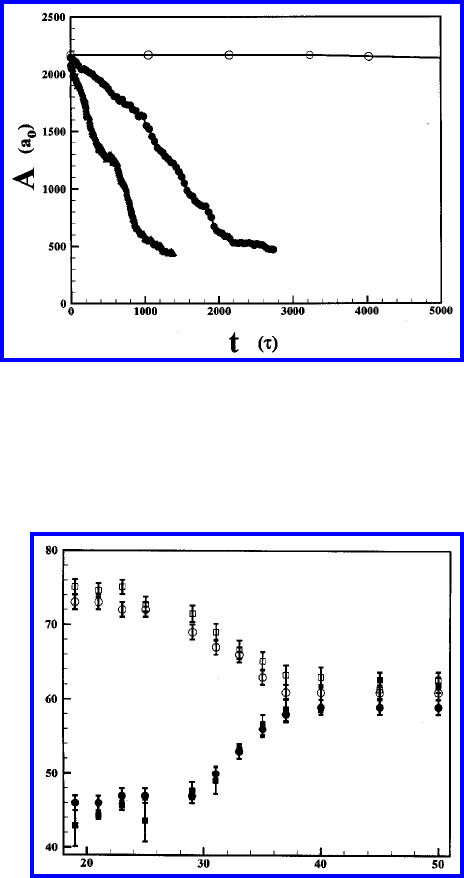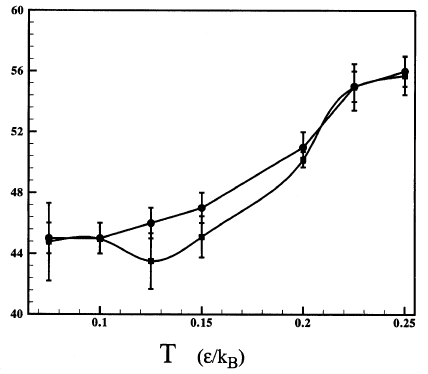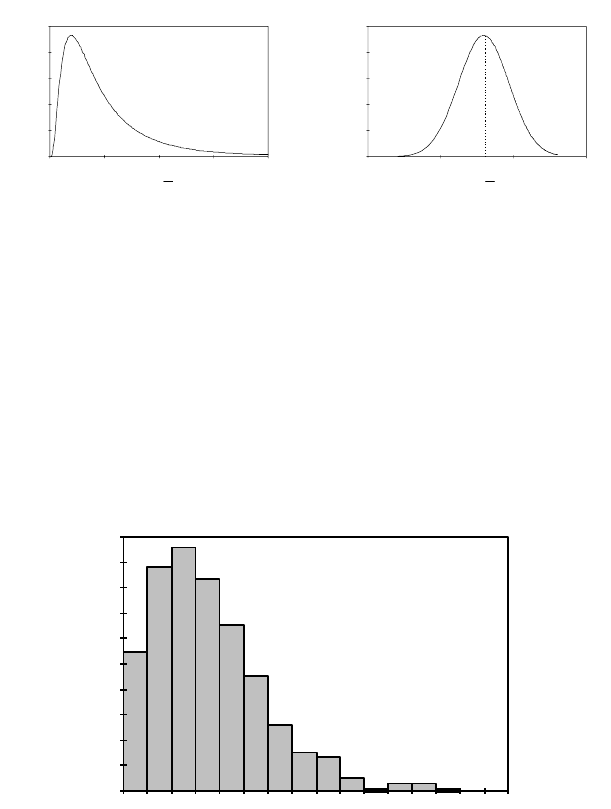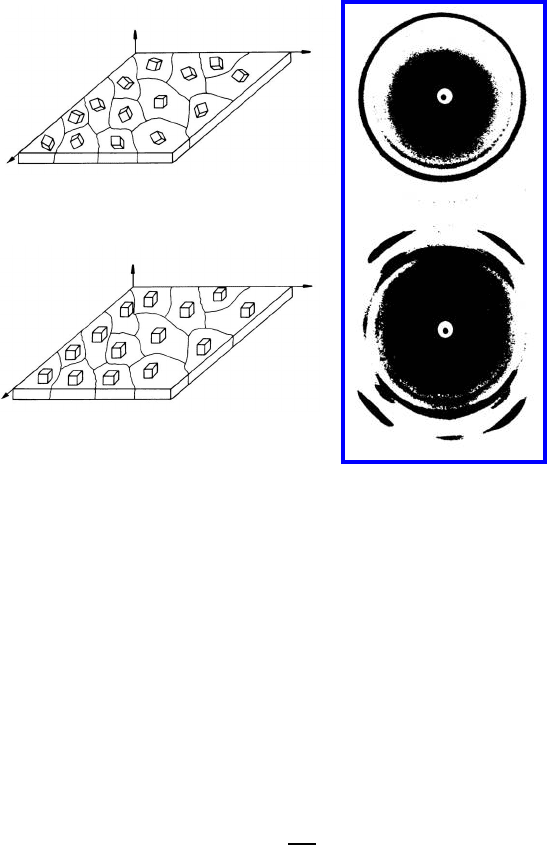Gottstein G., Shvindlerman L.S. Grain Boundary Migration in Metals: Thermodynamics, Kinetics, Applications
Подождите немного. Документ загружается.


506 5 Computer Simulation of Grain Boundary Motion
FIGURE 5.41
The rate of change in the area of the half-loop grain with and without triple
junctions for the same conditions as in Fig. 5.39. The filled and open circles
indicate the “+” and “–” geometries, respectively, and the shaded triangles
indicate the results of the bi-crystal simulation [440].
θ (
0
)
a (
r
o
)
θ (
0
)
a (
r
o
)
FIGURE 5.42
The dynamic triple junction angle θ
±
plotted as a function of the half-loop
grain width a, for both the “+” (filled symbols) and “–” (open symbols)
geometries and for simulation conditions ϕ =38.2
◦
and T =0.125ε/k
B
.
The circles indicate the directly measured dynamic angles while the squares
correspond to θ
−
from Figs. 5.41(a) and (b) [440].
© 2010 by Taylor and Francis Group, LLC
5.9 Simulation of Triple Junction Motion 507
a low of 60
◦
± 1
◦
toahighof74
◦
± 1
◦
for the “–” geometry. Of more im-
portance than the absolute value of the dynamic triple junction angle is the
deviation of this angle from its equilibrium value |θ
+
−θ
eq
|. While little or no
deviations (within the error bars) of the dynamic triple junction angles from
the static value of 60
◦
are common in the simulation performed, significant
deviations do occur at or very near low Σ misorientations: |θ
+
−θ
eq
| =16
◦
and
|θ
−
−θ
eq
| =14
◦
for Σ13 (ϕ =32.2
◦
)and|θ
+
−θ
eq
| =13
◦
and |θ
−
−θ
eq
| =1
◦
for Σ7 (ϕ =38.2
◦
). The observation of large deviations of the dynamic angle
from their equilibrium values appears strongly correlated with large devia-
tions of
˙
A
±
tj
from
˙
A
b
.
The variation of the dynamic angle θ
±
(as measured from figures such as
Figs. 5.36 and 5.37) with half-loop width is shown in Fig. 5.42. As the half-
loop width increases, the deviation θ
±
− θ
eq
decreases for both the “+” and
“–” geometries. For widths above approximately 40r
0
, the dynamic angle θ
±
is nearly indistinguishable from the static equilibrium value θ
eq
=60
◦
± 1
◦
.
These data suggest that at small half-loop width triple junction drag is sig-
nificant.
Fig. 5.43 shows the variation of θ
±
with temperature T ,whereθ
+
has been
directly measured from images of the migrating triple junction and deduced
from Figs. 5.39(a) and (b). Within the error bars of the determination of θ
+
,
both methods yield the same values. As the temperature increases, the devi-
ation of the dynamic angle from the static angle |θ
+
−θ
eq
| decreases. Similar
trends are also observed for the “–” geometry of Fig. 5.40(b). Substantial
deviations of θ
±
from its equilibrium value θ
eq
only occur for special misori-
entations, small grain size and relatively low temperature.
The results show that for low Σ misorientations and misorientations near
these, the dynamic triple junction angles deviate significantly from their equi-
librium values. This results in significantly slower boundary migration in the
tri-crystal geometries, as indicated by the extracted values of the rates of
change in area of the half-loop grain
˙
A
±
tj
.
The simulations confirm the experimental observations of non-equilibrium
triple junction angles and substantial triple junction drag seen in recent exper-
iments [183, 436]. One discrepancy between the experiments and simulations
is the conditions under which triple junction drag is significant. In the simu-
lations, triple junction drag was never found to substantially retard boundary
migration at grain sizes above approximately fifty inter-atomic spacings. On
the other hand, the experiments have demonstrated triple junction drag for
grain sizes in excess of 10 μm. This difference is likely attributable to the
presence of impurities on the grain boundaries in the experiments, while the
simulations model (intrinsic) migration in an ideally pure material. This sug-
gests that impurity effects, even in extremely high purity materials, may sub-
stantially influence grain boundary and triple junction migration because of
segregation effects. Such an explanation is meaningful since impurities affect
the triple junction and grain boundary mobility differently. Nonetheless, it is
© 2010 by Taylor and Francis Group, LLC

508 5 Computer Simulation of Grain Boundary Motion
θ (
0
)θ (
0
)
FIGURE 5.43
The dynamic triple junction angle β
+
d
vs. temperature T , for the “+” geometry
and for simulation conditions ϕ =38.2
◦
and T =0.125ε/k
B
.Thecircles
indicate the directly measured dynamic angles while the squares correspond
to θ
+
from Figs. 5.41(a) and (b) [440].
emphasized that according to experimental results and computer simulation
data that triple junction drag must always be considered for the thermal be-
havior of modern nano-structured materials.
© 2010 by Taylor and Francis Group, LLC

6
Applications
“Pooh felt that he ought to say something helpful
about it, but didn’t quite know what. So he decided
to do something helpful instead.”
— A.A. Milne
6.1 Characterization of Microstructure and Texture
6.1.1 Introductory Remarks
Because of the complexity of microstructures in crystalline solids, it is vir-
tually impossible to comprehensively characterize and, accordingly, represent
microstructures. The microstructure of commercial materials like hardened
steels or heavily deformed metals consists of complex morphological features,
defect arrangements and phase distributions even under high magnification,
i.e. on a nanoscale level.
For many applications only the macroscopic behavior of a material is of
practical interest and, therefore, the common approach in the past was the
correlation of macroscopic properties with average values of dominant mi-
crostructural features, usually features to be identified by optical microscopy,
like grain size and macroscopic phase distribution besides overall chemistry.
In crystalline solids the macroscopic properties are not necessarily isotropic,
i.e. equal for all specimen directions. This is due to the fact that the individual
crystals are non-random arrangements of atoms. On the contrary they con-
sist of strictly aligned atoms on a long-range periodic pattern. Therefore, the
physical properties of a crystal depend on the considered crystal direction, i.e.
physical properties of crystallites are anisotropic, which requires their repre-
sentation by a second rank tensor. A crystalline solid usually consists of many
crystallites (typically 10
6
/mm
3
). If the grains in a polycrystal are randomly
arranged, then the anisotropic properties of the individual crystallites aver-
age out, and the polycrystal behaves isotropically. During the processing of
a material to the final product, however, usually non-random distributions of
crystallite orientations are generated, which cause an anisotropic behavior of
509
© 2010 by Taylor and Francis Group, LLC

510 6 Applications
the macroscopic specimen. Therefore, in addition to the grain size and shape
as well as the phase distribution and morphology, the orientation distribution
is also of interest for macroscopic material behavior. The orientation distribu-
tion in crystalline solids is referred to as crystallographic texture, or simply
texture
1
.
The texture of a material is by definition a macroscopic average of the ori-
entations in a polycrystalline aggregate (macrotexture). On a more local scale,
the orientation distribution (microtexture) may be different from the macro-
scopic average, if orientation correlations exist, i.e. clustering of orientations
or preferred next neighbors. Evidently, in deformed microstructures the ori-
entation distribution in deformation inhomogeneities may be quite different
from the homogeneously deformed matrix.
While the macrotexture determines the anisotropy of a material property,
the microtexture provides information on the mechanisms of material behavior
and microstructure evolution. More specifically, the microtexture encompasses
the grain boundary character distribution so that all mechanisms involving
grain boundary processes will be primarily affected by this microtextural char-
acteristic.
In the framework of this text we will consider the effect of grain boundary
motion on microstructure and texture development. Correspondingly, we shall
confine microstructure characterization mainly to grain structures in single
phase materials, i.e. characterized by grain size distribution and morphology
as well as crystallographic texture, both on a macroscopic and microscopic
level. The main features of both characterization groups, grain structure and
texture, are textbook knowledge and thus will be only concisely reviewed in
the following.
6.1.2 Microstructure
The grain size y of a crystalline solid is practically never uniform; rather, there
is a grain size distribution Ψ (Fig. 6.1), which usually can be described by a
log-normal distribution
Ψ(y)dy =
1
√
2πσ
exp
⎛
⎜
⎝
−
1
2
⎡
⎣
ln
y
y
0
σ
⎤
⎦
2
⎞
⎟
⎠
d (ln y) (6.1)
1
We note at this point that the term texture is not understood unambiguously among the
disciplines concerned with crystalline solid. While in the materials science community tex-
ture is synonymous with crystallographic texture, in mineralogy or geology the term texture
stands for the morphological appearance of the usually complex minerals or rocks. There-
fore, geologists choose the term “preferred orientation” rather than texture. Of course, there
is also texture in textile fabrics, food and art with quite different meanings, but because
we are so far removed from these disciplines there is no need to differentiate meanings. We
shall refer to texture as crystallographic texture in the following.
© 2010 by Taylor and Francis Group, LLC

6.1 Characterization of Microstructure and Texture 511
Häufigkeit w(D)
1,0
0,8
0,6
0,4
0,2
0
0
1234
(D/D
0
)
Häufigkeit w(D)
1,0
0,8
0,6
0,4
0,2
0
0,01 0,1 1 10(ln D)
0
ln (D/D
0
)
(a) (b)
frequency w(D)
1.0
0.8
0.6
0.4
0.2
0
0
1234
frequency w(D)
1.0
0.8
0.6
0.4
0.2
0
0.01 0.1 1 10
(a) (b)
DD/
ej
DD/
ej
Häufigkeit w(D)
1,0
0,8
0,6
0,4
0,2
0
0
1234
(D/D
0
)
Häufigkeit w(D)
1,0
0,8
0,6
0,4
0,2
0
0,01 0,1 1 10(ln D)
0
ln (D/D
0
)
(a) (b)
Häufigkeit w(D)
1,0
0,8
0,6
0,4
0,2
0
0
1234
(D/D
0
)
Häufigkeit w(D)
1,0
0,8
0,6
0,4
0,2
0
0,01 0,1 1 10(ln D)
0
ln (D/D
0
)
(a) (b)
frequency w(D)
1.0
0.8
0.6
0.4
0.2
0
0
1234
frequency w(D)
1.0
0.8
0.6
0.4
0.2
0
0.01 0.1 1 10
(a) (b)
DD/
ej
DD/
ej
FIGURE 6.1
(a) Logarithmic normal distribution as given by Eq. (6.1) plotted linearly
(normalized to mean grain size
¯
D). The maximum is not at D/
¯
D =1.(b)
Plot of the distribution in (a) over the logarithm of grain size. The distribution
is symmetrical.
201816
14
12108642
0
20
18
16
14
12
10
8
6
4
2
22 24 26 28 30 32
frequency
D [μm]
201816
14
12108642
0
20
18
16
14
12
10
8
6
4
2
22 24 26 28 30 32
frequency
D [μm]
FIGURE 6.2
Histogram of grain size distribution in recrystallized Fe-17%Cr commercial
sheet metal (70% rolled, annealed 250 min. at 1050
◦
C).
© 2010 by Taylor and Francis Group, LLC

512 6 Applications
Here, lny
0
is the mean value of lny and σ is the width of the distribution and
Ψ(y
∗
)dy represents the frequency of grains of size y with y
∗
≤ y ≤ y
∗
+ dy.
In a linear plot Ψ(y)vs.y the distribution is asymmetrical (Fig. 6.2) and,
therefore, the most frequent value y
0
(median) does not coincide with the
average value (mean) ¯y.Rather,y
0
and ¯y are related by
y
0
=exp
ln ¯y − σ
2
(6.2)
i.e. y
0
< ¯y. The log-normal distribution does not follow easily from fundamen-
tal considerations. On the contrary, from theoretical models of grain growth,
the stationary grain size distribution, which would satisfy
d
dt
Ψ
ln
y
y
0
=0 (6.3)
does not yield a log-normal distribution but a distribution, which is not ob-
served in real grain structures. This contradiction is commonly reconciled by
the assumption that the kinetic processes, which modify the grain structure
toward a steady-state, cease to operate before a stationary distribution is at-
tained, and the log-normal distribution represents an approximation of the
non-stationary structure.
The mathematical grain size distribution as expressed in terms of Eq. (6.1)
and displayed in Fig. 6.1 relates to an infinitely large assembly of grains.
Despite the large number of grains in a polycrystal (10
6
/mm
3
) one would
probably not find any grain with a precisely given grain size. Therefore, ex-
perimental grain size distributions are represented in terms of histograms,
where the frequency of grains in a given size interval is plotted as a bar graph
(Fig. 6.2).
Neither the average grain size nor the grain size distribution can provide
a comprehensive description of polycrystalline aggregates. Grain morphology
and topology are rarely accounted for, since stereology requires laborious spec-
imen handling for a 3D image of the grain assembly. Grain shape — in terms
of ellipticity — or distribution of the number of grain edges and corners can
be determined to more adequately represent the grain structure. However,
owing to the extraordinary efforts involved in gaining this information exper-
imentally, it is only collected on particular need, e.g. if grain topology plays a
role for the problem under consideration, as in a comprehensive treatment of
grain growth. Nowadays, powerful image analysis systems, which allow digital
storage of metallurgical micrographs, i.e. sections through grain assemblies,
are now becoming available to facilitate stereological evaluation.
The quantitative evaluation of heterogeneous microstructures from 2D sec-
tions is the subject of textbooks on stereology and image analysis systems.
In the context of grain boundaries in single phase materials areas of primary
interest usually include grain size, grain shape and spatial orientation of grain
boundary planes. There are two basic methods to determine the average grain
size: lineal and areal analysis. An automated image analysis system will reveal
© 2010 by Taylor and Francis Group, LLC

6.1 Characterization of Microstructure and Texture 513
the boundaries in a planar section and determine the mean cross section
¯
A of
a grain, from which the mean grain size
¯
D can be derived, assuming equiaxed
grain shape
¯
D =
!
¯
A (6.4)
For manual evaluation of micrographs from planar sections, it is most common
to superimpose parallel lines to the microstructure such that any single grain
is intersected only once by a line. Then the number N of intersections of grain
boundaries with the total line length L is counted to yield the average grain
size
¯
D
¯
D =
L
N
(6.5)
as a mean linear intercept. In the case of nonequiaxed microstructures the
linear intercepts in three perpendicular directions
¯
D
1
,
¯
D
2
,
¯
D
3
have to be
determined, requiring two mutually perpendicular sections, to yield
¯
D =
¯
D
1
·
¯
D
2
·
¯
D
3
1/3
(6.6)
The ratios
¯
D
1
/
¯
D
2
,
¯
D
2
/
¯
D
3
,
¯
D
1
/
¯
D
3
denote the respective ellipticity or aspect
ratio.
A quantity of particular interest with regard to grain boundaries is the
surface area A
v
per unit volume, which is found to be [565]
A
v
=
2
¯
D
=2·
N
L
≡ 2N
L
(6.7)
In the case of non-equiaxed microstructures
A
v
=0.429 N
L1
+2.571N
L3
− N
L2
∼
=
0.429
¯
D
2
¯
D
1
+2.571
¯
D
2
¯
D
3
− 1
N
L2
(6.8)
where N
Li
represents the respective inverse linear intercepts or boundary
counts per unit length [566].
6.1.3 Crystallographic Texture
6.1.3.1 Definitions
Metallic materials are crystalline, i.e. within a crystallite the atoms are ar-
ranged in a strictly periodic pattern, which is represented by the crystal-
lographic unit cell of the particular crystal structure. While all grains of a
polycrystal have the same crystal structure, the orientation of the unit cell
with respect to the macroscopic specimen coordinate system changes from
grain to grain. This relationship between spatial orientation of the crystal-
lographic unit cell as defined by its fundamental crystallographic axes and
the macroscopic specimen system as defined by its characteristic directions is
referred to as crystallographic orientation. The distribution of orientations in
© 2010 by Taylor and Francis Group, LLC

514 6 Applications
(a)
(b)
ND
ND
RD
RD
TD
TD
(a)
(b)
ND
ND
RD
RD
TD
TD
FIGURE 6.3
Schematic representation of the orientation distribution and the resulting
Debye-Scherrer images in sheet metal with (a) random distribution; (b) when
a preferred orientation exists (here: Cube texture).
a polycrystal is termed its crystallographic texture, or simply texture. Real
textures comprise very different cases, from a random orientation distribution
(random or gray texture) to a single component texture, the extreme of which
would be a single crystal (Fig. 6.3).
Quantitatively, the texture is represented by the orientation distribution
function (ODF) f (g) [567, 568], where f (g
∗
)dg is the specimen volume fraction
dV/V with orientation g
∗
in the interval g
∗
≤ g ≤ g
∗
+ dg, i.e.
f(g)dg =
dV
V
(6.9)
Since the orientation of a cubic crystal is defined as the relation between the
(orthonormal) crystal axes and the (orthonormal) specimen axes, it is mathe-
matically represented by the rotation that makes the specimen axes align with
the crystal axes. There is an infinite number of ways to prescribe a procedure
of rotations that makes two coordinate systems coincide. Irrespective of the
procedure, however, the rotation is mathematically formulated in a unique
way, namely by the rotation matrix g, which is defined as
r
= gr (6.10)
© 2010 by Taylor and Francis Group, LLC

6.1 Characterization of Microstructure and Texture 515
where r represents any vector of the unrotated system and r
is the corre-
sponding vector in the rotated system. By using the bases of the two systems
to define the vector r or r
it is obvious that the columns of the (3 x 3) matrix
g correspond to the direction cosines of the base vectors of the rotated system
with respect to the unrotated system.
Three quantities are necessary to describe a rotation in three dimensions,
for example three angles of subsequent rotations around prescribed axes. Since
there is an infinite set of three axes, there is an infinite number of ways to
put up the rotation matrix. There are three ways which are most convenient
and, therefore, most commonly used to describe an orientation relationship
(Fig. 6.4c):
a) Axis and angle of rotation: ω[HKL] (Fig. 6.4a). It is easy to imagine and
readily handled in stereographic projection. The notation is especially useful
for the treatment of problems related to grain boundaries, as the type of grain
boundary is commonly defined by the orientation of the boundary plane with
respect to the axis of rotation
2
(see Chapter 2).
b) Miller indices (Fig. 6.4c): 2 crystallographic directions in coordinate system
1, which are parallel to the base vectors of coordinate system 2. For instance,
for rolling geometry parallel to rolling plane normal: (hkl) and rolling direc-
tion: [uvw]. It is commonly used when the crystal lattice is to be related to
the specimen coordinate system, e.g. in a tensile sample with respect to the
tensile axis or for rolling geometry with respect to rolling plane and rolling
direction.
c) The three Euler angles (Fig. 6.4b): ϕ
1
,Φ,ϕ
2
.Thisiswidelyusedforan
analytical treatment of rotations. It is standard for the calculation and repre-
sentation of textures in terms of the three-dimensional orientation distribution
function (ODF).
The rotation matrix g is only unique if there is no crystal symmetry [568].
In cubic crystals there is a 24-fold symmetry, i.e. there are 24 different rota-
tions S
c
i
which do not change the position of lattice points. Each rotation g
may, therefore, be superimposed by any combination of S
c
i
to give an equiva-
lent orientation of the rotated lattice. Any of the 24 different orientations of
a vector r
i
in cubic lattices is, therefore, obtained by
r
i
= S
c
i
· g · r
i
(6.11)
2
This definition of the grain boundary character is not unambiguous in crystal structures of
high symmetry, like the cubic lattice. Depending on the choice of the 24 possible symmetry
elements in a cubic lattice, a grain boundary may be either tilt or twist boundary. An
example gives the coherent twin plane in fcc crystals. Its Miller indices (plane normal) are
{111}, in particular (111). The twin orientation can be described by a 60
◦
[111] rotation. In
this case the (111) boundary plane is a twist boundary. A symmetrically equivalent rotation
is 70.6
◦
[1
¯
10]. The coherent twin boundary is now a tilt boundary. Therefore, for uniqueness
in highly symmetric lattices additional rules of selection have to be applied. Unambiguity
is attained by selection of the smallest angle of rotation.
© 2010 by Taylor and Francis Group, LLC
